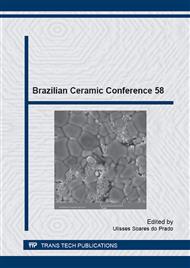[1]
E.S. Fujikawa: Incorporation of chromium powder, residues in civil construction materials. Master (Dissertation). Bauru, 2002. Universidade Estadual Paulista (UNESP). (SP) (In Portuguese).
DOI: 10.5212/terraplural.v.15.2118016.034
Google Scholar
[2]
S.Y. Yuan: Study of the influence of adding chemically treated leather powder in the Portland cement mortar characteristics. Master (Dissertation). São Carlos, 2009. Universidade Federal de São Carlos (UFSCar). SP. (In Portuguese).
DOI: 10.21115/jbes.v14.suppl2.p180-6
Google Scholar
[3]
A.L.R.S. Tachard: Evaluation of mechanical resistance of Portland cement mortar with leather powder treated in acidic media. Master (Dissertation). Florianópolis, 2006. Federal University of Santa Catarina (UFSC). (SC) (In Portuguese).
Google Scholar
[4]
C.A. Pinto: Stabilization through cement solidification of leather tanning residue containing chromium. Master (Dissertation). São Paulo, 2001. Universidade de São Paulo (USP). (SP). (In Portuguese).
DOI: 10.29381/0103-8559/20213103334-44
Google Scholar
[5]
M.P. Santos: Soil-cement manufacture with addition of wooden residues from civil construction. Master (Dissertation). São Carlos, 2006. Universidade Federal de São Carlos (UFSCar). SP. (In Portuguese).
DOI: 10.21115/jbes.v14.suppl2.p180-6
Google Scholar
[6]
J.G.M. PERES: Feasibility of using leather powder for obtaining alternative construction material. Master (Dissertation). Campinas, 2004. Universidade Estadual de Campinas (UNICAMP). (SP) (In Portuguese).
DOI: 10.29381/0103-8559/20203004521-5
Google Scholar
[7]
Brazilian Association of Technical Regulation. Soil-cement compact brick using manual pressing. Rio de Janeiro: ABNT 1989. (NBR 10832) (In Portuguese).
Google Scholar
[8]
Brazilian Association of Technical Regulation. –Tijolo maciço de solo-cimento – Determination of compressive strengh and water absorption. Rio de Janeiro: ABNT 1984. (NBR 8491). (In Portuguese).
Google Scholar
[9]
Brazilian Association of Technical Regulation. Procedures for obtainment of leaching extract from solid residues. Rio de Janeiro: ABNT 2004. (NBR 10005). (In Portuguese).
Google Scholar
[10]
Brazilian Association of Technical Regulation. Soil – Granulometric analysis. Rio de Janeiro: ABNT 1984. (NBR 7181). (In Portuguese).
Google Scholar
[11]
Brazilian Association of Technical Regulation. Soil – Determination of plasticity limits. Rio de Janeiro: ABNT 1984. (NBR 7180). (In Portuguese).
Google Scholar
[12]
Brazilian Association of Technical Regulation. Soil – Determination of liquidity limits. Rio de Janeiro: ABNT 1984. (NBR 6459). (In Portuguese).
Google Scholar
[13]
Brazilian Association of Technical Regulation. Soil - #4, 8mm sieve passing- Determination of specific mass. Rio de Janeiro: ABNT1984. (NBR 6508). (In Portuguese).
Google Scholar
[14]
Brazilian Association of Technical Regulation. Compactation testing. Rio de Janeiro: ABNT1986). (NBR 7182). (In Portuguese).
Google Scholar
[15]
Brazilian Association of Technical Regulation. Procedures for obtainment of solubilization extract from solid residues. Rio de Janeiro: ABNT 2004. (NBR 10006). (In Portuguese).
Google Scholar
[16]
Brazilian Association of Technical Regulation. Solids - Classification. Rio de Janeiro: ABNT 2004. (NBR 10004). (In Portuguese).
Google Scholar


